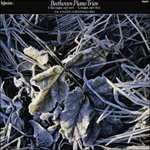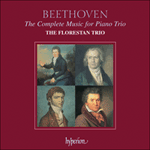
Welcome to Hyperion Records, an independent British classical label devoted to presenting high-quality recordings of music of all styles and from all periods from the twelfth century to the twenty-first.
Hyperion offers both CDs, and downloads in a number of formats. The site is also available in several languages.
Please use the dropdown buttons to set your preferred options, or use the checkbox to accept the defaults.

| London Fortepiano Trio» More |
Despite Haydn’s misgivings about the C minor, Beethoven’s Op 1 was enthusiastically received by both ‘connoisseurs’ and amateur musicians (‘Kenner und Liebhaber’ – a favourite eighteenth-century distinction), and made the composer a handsome profit. Yet with their largely emancipated string parts, their weighty, extended sonata structures and their intensity of musical dialectic, the three works must have seemed like a headlong assault on the traditional notion of the piano trio as a small-scale domestic genre. Each of the trios is in four movements rather than the two or three expected in chamber music with piano: these are not elevated divertissements, but symphonies for three instruments. And if the cello sometimes doubles the keyboard bass, as it rarely does in Beethoven’s later trios, it often asserts its individuality in a way that Mozart only intermittently and Haydn almost never allowed.
The first two movements of the E flat major Trio, No 1, are the most obviously Mozartian in the set, though the opening Allegro’s textural richness, thematic abundance and sheer breadth of scale are hallmarks of the young Beethoven. There is expansion at almost every level: say, in the second group’s leisurely proliferation of themes, beginning with a quiet chorale-like melody spiced with sforzando accents; or in the huge coda, in effect a second development, where first piano and then strings further exploit the movement’s opening ‘rocket’ figure, at one point nonchalantly turning it upside down.
The Adagio cantabile in A flat is just as expansive, a luxuriant rondo with a first episode fashioned as a soulful love duet for violin and cello (in its eloquent middle and upper registers) and an impassioned second episode in the outré key of A flat minor – calculated to appeal to the Kenner among Prince Lichnowsky’s audience. The third movement is the most subversively original in the work, and the first of Beethoven’s true scherzi: with its initial tonal ambiguity (the music feints at C minor, F minor and B flat before finally establishing E flat in bar 15), its comical obsession with the ‘flicking’ opening figure, and its mingled cussedness and mercurial lightness, it leaves its minuet model far in the background.
If the spirit of Mozart lies behind the first two movements, the sonata-form finale suggests Haydn in its verve and brilliance, and in the witty capital Beethoven makes of the initial leaping figure. But the coda is again expanded beyond Haydn’s dimensions into a second development. Its sly opening shift from E flat to E major and subsequent fortissimo wrench back again are an early example of a Beethoven ploy that will find its comic apotheosis in the finale of the Eighth Symphony.
from notes by Richard Wigmore © 2004
Malgré les réserves haydniennes quant au trio en ut mineur, l’op.1 de Beethoven reçut un accueil enthousiaste des connaisseurs et des musiciens amateurs (des «Kenner und Liebhaber», pour reprendre une distinction courante au XVIIIe siècle) et assura au compositeur un joli profit. Pourtant, avec leurs parties de cordes largement émancipées, leurs structures de sonate pesantes, prolongées, et leur dialectique musicale intense, ces trois œuvres ont dû faire figure d’assaut impétueux contre la notion traditionnelle du trio avec piano conçu comme un genre domestique à petite échelle. Chacun de ces trios compte ainsi quatre mouvements, au lieu des deux ou trois habituellement attendus dans la musique de chambre avec piano: ce ne sont pas des divertissements élevés, mais des symphonies pour trois instruments. Et si le violoncelle double parfois la basse du clavier – ce qui se produit rarement dans les trios beethovéniens ultérieures –, il affirme souvent son individualité d’une manière que Mozart ne s’autorisa que par intermittence et Haydn presque jamais.
Les deux premiers mouvements du Trio en mi bémol majeur no1 sont les plus ouvertement mozartiens du corpus, même si la richesse de texture, la luxuriance thématique et l’ampleur d’échelle de l’Allegro sont le sceau du jeune Beethoven. L’accroissement est présent à presque tous les niveaux: dans la tranquille prolifération de thèmes du second groupe, qui s’ouvre sur une paisible mélodie de type choral épicée d’accents sforzando, mais aussi dans l’énorme coda, en réalité un second développement, où le piano, puis les cordes, exploitent plus avant la figure de «fusée» initiale du mouvement, la mettant, à un moment, à l’envers.
L’Adagio cantabile en la bémol, tout aussi expansif, est un luxuriant rondo qui voit un premier épisode façonné en un attendrissant duo d’amour pour violon et violoncelle (dans ses éloquents registres moyen et aigu) précéder un fervent second épisode sis dans la tonalité outrancière de la bémol mineur – destinée à séduire les Kenner de l’auditoire du prince Lichnowsky. Le troisième mouvement, le plus subversivement original de l’œuvre, est le premier vrai scherzo de Beethoven: son ambiguïté tonale initiale (la musique feinte vers ut mineur, fa mineur et si bémol avant de finalement instaurer mi bémol à la mesure 15), son obsession comique quant à la figure d’ouverture «subite» et son entêtement mêlé d’une légèreté pleine d’entrain lui permettent de laisser loin derrière lui son modèle de menuet.
Si l’esprit de Mozart plane sur les deux premiers mouvements, le finale de forme sonate évoque Haydn tant par sa verve et son éclat que par l’intelligente exploitation de sa figure bondissante initiale. Mais, de nouveau, la coda est amplifiée bien au-delà des dimensions haydniennes dans un second développement. Son astucieuse transition d’ouverture, de mi bémol à mi majeur, et la torsion fortissimo subséquente sont la manifestation précoce d’un stratagème beethovénien qui trouvera son apothéose dérisoire dans le finale de la Huitième symphonie.
extrait des notes rédigées par Richard Wigmore © 2004
Français: Hypérion
Trotz Haydns Bedenken bezüglich des c-Moll-Trios fand Beethovens Opus 1 begeisterte Aufnahme bei Kennern ebenso wie bei Amateurmusikern („Kenner und Liebhaber“ – eine beliebte Unterscheidung im achtzehnten Jahrhundert) und brachte dem Komponisten einen ansehnlichen Profit ein. Doch mit ihren weitgehend unabhängigen Streicherstimmen, den gewichtigen, erweiterten Sonatensatzformen und der Intensität ihrer musikalischen Dialektik müssen die drei Werke wie ein ungestümer Angriff auf die traditionelle Vorstellung vom Klaviertrio als häusliche Kleinform gewirkt haben. Alle drei Trios stehen in vier Sätzen statt der zwei oder drei, die von Kammermusik mit Klavier zu erwarten wäre: Dies sind keine besseren Divertissements, sondern Sinfonien für drei Instrumente. Und wenn das Cello auch manchmal die Basslinie im Klavier verdoppelt, was bei Beethovens späteren Trios selten der Fall ist, pocht das Instrument oft in einer Weise auf seine Individualität, die ihm Mozart nur gelegentlich und Haydn fast nie gestattete.
Die ersten beiden Sätze des Trios in Es-Dur Nr. 1 erinnern von allen aus Opus 1 am ehesten an Mozart, obwohl der strukturelle Reichtum, die Themenfülle und die schiere Breite der Anlage den jungen Beethoven auszeichnen. Es findet sich Erweiterung auf allen Ebenen, so z.B. in der gemächlichen Themenwucherung der zweiten Gruppe, angefangen mit einer leisen choralartigen Melodie, gewürzt mit sforzando-Akzenten; oder in der umfangreichen Coda, die im Grunde eine zweite Durchführung darstellt – hier beuten erst das Klavier und dann die Streicher die einleitende Raketenfigur des Satzes weiter aus und stellen sie einmal sogar nonchalant auf den Kopf.
Das Adagio cantabile in As-Dur ist ebenso expansiv, ein reich ausgeschmücktes Rondo mit einer ersten Episode, die als gefühlvolles Liebesduett für Violine und Cello (in seinem ausdrucksvollen mittleren und oberen Register) gestaltet ist, und einer leidenschaftlichen zweiten Episode in der extravaganten Tonart as-Moll – darauf angelegt, den Kennern unter den Zuhörern im Salon des Fürsten Lichnowsky zu gefallen. Der dritte Satz ist der subversiv originellste des Werks und das erste von Beethovens echten Scherzi: In seiner anfänglichen tonalen Mehrdeutigkeit (die Musik fintiert nach c-Moll, f-Moll und B-Dur, ehe sie sich im 15. Takt schließlich auf Es-Dur festlegt), seiner ulkigen Versessenheit auf die „schnalzende“ Figur der Einleitung und der Mischung aus Sturheit und quecksilbriger Leichtigkeit lässt er das Menuett, das ihm als Vorbild dient, weit hinter sich zurück.
Wenn die ersten beiden Sätze dem Geiste Mozarts verhaftet sind, so gemahnt das schwungvoll-brillante Finale in Sonatensatzform an Haydn, insbesondere in der Art, wie Beethoven aus der einleitenden springenden Figur geistreich besonderes Kapital schlägt. Die Coda ist jedoch wiederum weit über die Dimensionen Haydns hinaus zu einer zweiten Durchführung erweitert. Ihr verschlagener Wechsel von Es-Dur nach E-Dur zu Anfang, gefolgt von der fortissimo gespielten Rückführung, ist ein frühes Beispiel für ein Beethovensches Manöver, das im Finale der Achten Sinfonie seine komische Apotheose findet.
aus dem Begleittext von Richard Wigmore © 2004
Deutsch: Anne Steeb/Bernd Müller
 Beethoven: Piano Trios Beethoven: Piano Trios‘Accomplished and beautifully recorded performances’ (Gramophone)» More |
 Beethoven: The Complete Music for Piano Trio Beethoven: The Complete Music for Piano TrioEach instalment of The Florestan Trio’s Beethoven Piano Trio cycle was rapturously received. Now reissued as a special-price box-set, this superb series of benchmark recordings should not be missed.» More |

